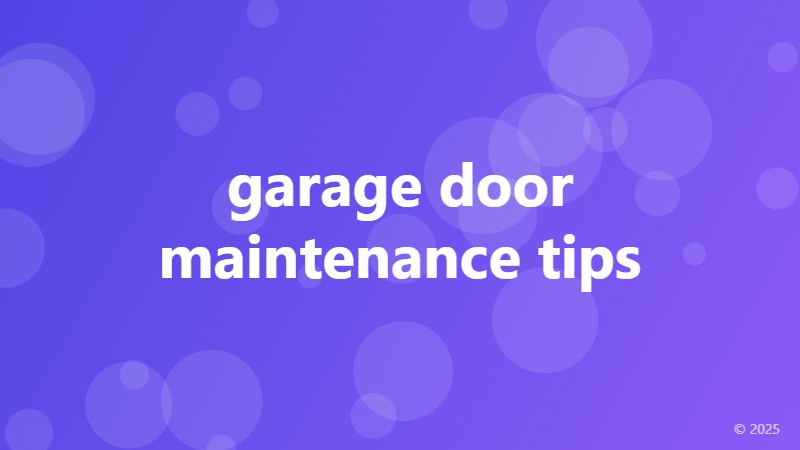garage door maintenance tips
 ```html
```html
Regular Garage Door Maintenance: Keeping Your Door Running Smoothly
A well-maintained garage door is more than just a convenience; it's a crucial part of your home's security and curb appeal. Ignoring regular maintenance can lead to costly repairs and even dangerous malfunctions. This comprehensive guide provides essential garage door maintenance tips to keep your door operating efficiently and safely for years to come.
Visual Inspection: The First Line of Defense
Before diving into any hands-on work, perform a thorough visual inspection of your entire garage door system. Look for any signs of damage, wear, or potential problems. This includes checking the tracks for any bends, obstructions, or rust; inspecting the rollers for wear and tear; and examining the springs and cables for fraying or breakage. Pay close attention to the door itself, looking for dents, cracks, or any signs of damage from impacts. A regular visual inspection, ideally monthly, can prevent small problems from escalating into major issues.
Lubrication is Key: Smooth Operation and Extended Lifespan
Proper lubrication is crucial for smooth and quiet garage door operation. Apply a high-quality garage door lubricant (not WD-40, as it’s not designed for long-term lubrication) to all moving parts, including hinges, rollers, tracks, and the chain or belt drive mechanism. This reduces friction, prevents rust, and extends the lifespan of your garage door components. Remember to always disconnect the power before lubricating any moving parts to ensure safety.
Tighten Loose Bolts and Screws: Preventing Wobbles and Misalignments
Over time, bolts and screws can loosen due to vibrations and general wear and tear. Regularly check for any loose fasteners on the tracks, hinges, and other parts of the garage door system. Tighten any loose bolts or screws using the appropriate tools to ensure everything is securely fastened and aligned. This prevents rattling, squeaking, and potential misalignments that can lead to more significant problems.
Inspect and Test the Safety Sensors: Ensuring Safe Operation
Safety sensors are crucial for preventing accidents. These sensors are located near the bottom of the garage door tracks and detect obstructions in the door's path. Test your safety sensors regularly by placing a small object (like a broom handle) in their path. The door should reverse automatically when it encounters the object. If it doesn’t, you may need to adjust the sensors or contact a garage door professional.
Inspect and Clean the Tracks: Removing Obstructions and Preventing Wear
Garage door tracks often accumulate debris like dust, leaves, and small rocks. Regularly clean the tracks using a brush or shop vacuum to remove any obstructions. This prevents the rollers from binding and ensures smooth operation. You can also use a degreaser to remove any built-up grime or grease. After cleaning, lubricate the tracks as described above.
Check the Springs and Cables: Identifying Potential Hazards
Garage door springs and cables are under significant tension and can be dangerous if improperly handled. Inspect the springs and cables for any signs of wear, fraying, or breakage. If you notice any damage, it’s crucial to contact a qualified garage door technician immediately. Never attempt to repair or replace garage door springs yourself, as this can be extremely dangerous.
Regular Professional Maintenance: Peace of Mind and Extended Lifespan
While regular DIY maintenance is essential, scheduling professional inspections and maintenance every year or two is highly recommended. A qualified technician can perform a thorough inspection, identify potential problems before they become major issues, and address any necessary repairs or replacements. This proactive approach helps to extend the lifespan of your garage door and ensures its safe and reliable operation.
Troubleshooting Common Garage Door Problems
Even with regular maintenance, you might encounter some minor garage door problems. Knowing how to troubleshoot some common issues can save you time and money. For instance, a squeaking noise often indicates the need for lubrication. A slow-opening or closing door might signify issues with the springs or motor. However, for complex issues or those involving safety concerns, it's always best to contact a professional.
Choosing the Right Lubricant for Your Garage Door
Not all lubricants are created equal. Choose a lubricant specifically designed for garage doors. These lubricants are formulated to withstand extreme temperatures and provide long-lasting lubrication without attracting dirt or dust. Avoid using WD-40 or other general-purpose lubricants, as they can actually attract dirt and accelerate wear and tear.
Conclusion: A Well-Maintained Garage Door is a Safe Garage Door
Following these garage door maintenance tips will significantly improve your garage door’s lifespan, enhance safety, and keep your home secure. Remember, prevention is key; regular inspection and proactive maintenance are far more cost-effective than dealing with costly repairs down the line.
```